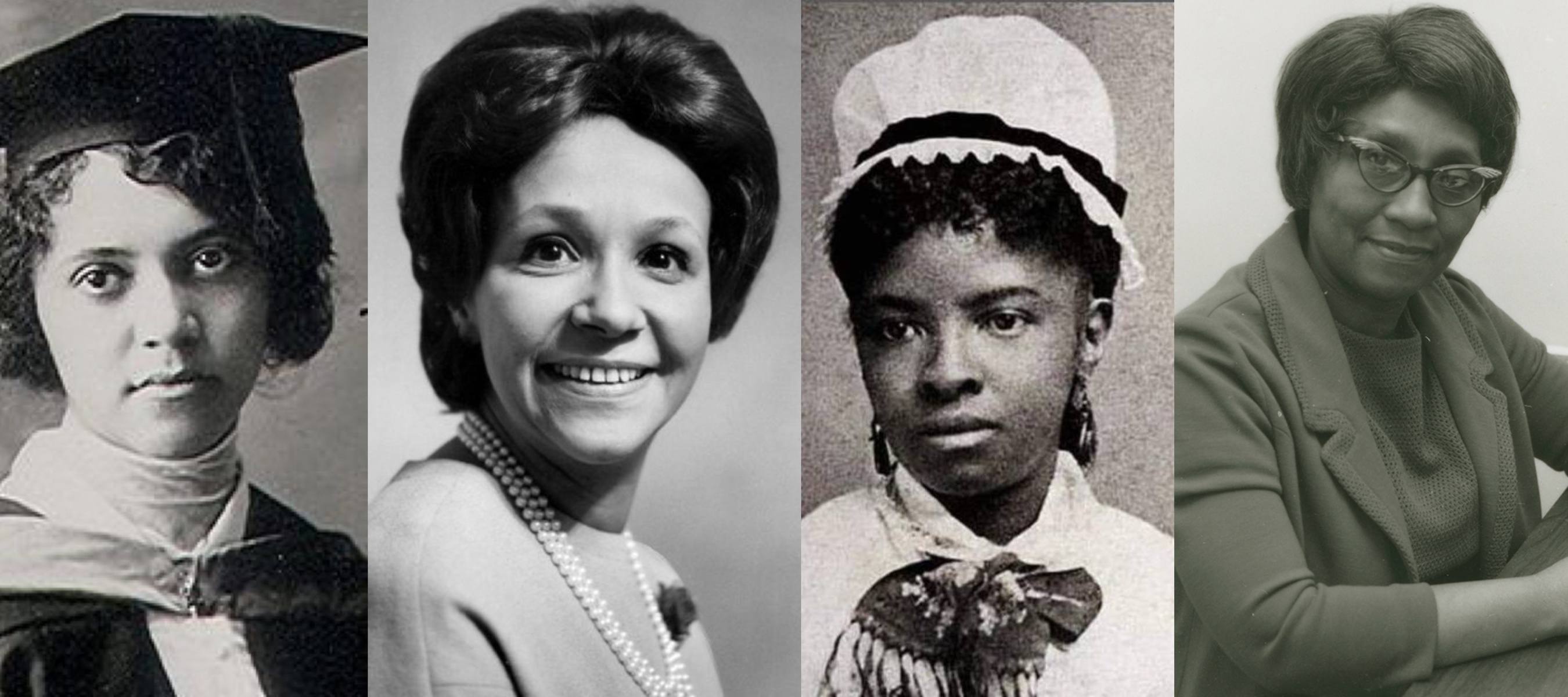Black History Month is an annual celebration of the achievements of Black Americans in U.S. History. We have gathered together a few highlights on people, primarily women, in medicine and science, who have inspired and impacted us.
The Black Panther Party
The Black Panther Party helped introduce acupuncture to the U.S. mainstream through their free healthcare programs that brought acupuncture to communities all over the States. These programs originally started in the ’70s because of the drug crisis in the inner-city black population.
The Black Panthers were fed up with the government’s lack of assistance in regards to the drug crisis, and they took matters into their own hands. One day, the Black Panther Party, together with members of what was known as the Health Revolutionary Unity Movement, walked into the nurse’s residence building at Lincoln Hospital and claimed it as their own.
This building was no longer functioning anyway, so they decided to turn it into something useful. After dealing with the police trying to shut them down (though not succeeding), they started the first treatment center for black people that used acupuncture to help with treating addiction.
The NADA protocol was created in this center, and it is now used in hospitals, veteran centers, and rehab centers all over the country. Their contribution to acupuncture didn’t stop there – they went on the create one of the first acupuncture schools in America called the Harlem Institute of Acupuncture.
Acupuncture achieving popularity and hitting the mainstream in the U.S. is in many thanks to the Black Panther Party for forging forward with their knowledge of acupuncture and its many uses to treat people.
Alice Ball, Chemist
Alice Ball was a chemist who, in her early twenties, developed the most effective treatment for leprosy, which was used for decades. Prior to Ball’s discovery, traditional healers in India and parts of Southeast Asia used a specific oil from the Chaulmoogra tree to treat leprosy either through ingestion or topically on the skin. They weren’t able to administer it intravenously as the oil was incredibly thick, which meant excruciating injections. Ultimately, this would be the key.
Enter: Alice Ball. She was a chemist with dual bachelor’s degrees from the University of Washington in pharmaceutical chemistry and pharmacy. She moved to Hawaii to do graduate work. She became the first African American and the first woman to graduate from the University of Hawaii with a master’s degree.
In 1916, Ball successfully isolated the fatty acid compounds from the oil (now known to be the antimicrobial hydnocarpic acid) and made the first preparation of a water-soluble, injectable form of chaulmoogra oil. The treatment was used globally for 30 years.
Ball died when she was 24 years old, just one year after her discovery. The President of the University of Hawaii, Arthur Dean, “continued her studies” and claimed he had made the discovery himself and even went on to call it the “Dean Method.” In 2000, almost a century after Ball’s discovery, the University of Hawaii officially, and finally, recognized Ball for her groundbreaking discovery.
Dr. Jane Cooke Wright, Physician and Cancer Researcher
Dr. Jane Cooke Wright was a physician and cancer researcher who defied both gender and racial barriers in a profession long dominated by white men. She dedicated her career to the advancement of cancer treatment and helped make chemotherapy a viable treatment option.
In the 1940s, chemotherapy was thought of as a “last resort” and was still in the experimental stages of drug development. As a result, the types of drugs available (as well as their prescribed dosages) weren’t well defined.
From an already distinguished medical family, Wright began her career as a researcher, working alongside her father at a cancer center he established at Harlem Hospital in New York.
Together, Jane and her father were among the first groups of researchers to discover the use of nitrogen-mustard as a treatment for cancer that led to remissions in patients with several major cancer types. Before this, many blood cancers were seen as incurable. When her father died in 1952, She took over as director of the Harlem Hospital Cancer Research Foundation.
In 1967, Dr. Wright became a professor of surgery at New York Medical College. At the time, she was the highest-ranking African American woman in a United States medical institution.
Her contributions to chemotherapy research have helped to change the face of medicine and continue to be used to this day.
Rebecca Lee Crumpler, Physician and Author
In 1864, a time where advanced education for women was rare, Dr. Crumpler graduated from medical school and became the first African American woman to earn a medical degree in the United States.
She started her first medical practice in Boston, but when the war ended in 1865, she moved to Richmond, Virginia, to help the freed slaves who otherwise would not have had access to medical care. In Crumpler’s words, racism was still widespread, which made it “a proper field for real missionary work.”
A few years later, in 1869, she returned to Boston and created a new practice centered around caring for women and children. Passionate about women’s health, she wrote A Book of Medical Discourses: a book for women to provide them with information on how to care for their own health and the health of their families.
Dr. Helen Octavia Dickens, Physician and Professor
Dr. Helen Octavia Dickens was born in 1909 in Dayton, Ohio, to Charles Warren Dickens, a former slave and water boy during the Civil War, and Daisy Jane Dickens, a domestic servant to the Reynolds family of paper manufacturers. Though her father was an educated man (he took his name after meeting the famous English novelist Charles Dickens), social prejudice restricted him to janitorial work. Helen was adamant that the same wouldn’t happen to her despite the abuse that she had encountered from her classmates early on in life.
Helen attended the University of Illinois after Dr. Elizabeth Hill, the first African American to graduate from the institution, helped her register. She earned her M.D. in 1934 as the only African American to do so. After completing her internship at Provident Hospital, a predominantly African American and poorly funded hospital in south Chicago, Dr. Dickens got her first job at Virginia Alexander’s Aspiranto Health Home in Philadelphia in 1935, where she, in addition to her general practice, provided obstetric and gynecologic care.
Following six successful years in Philadelphia, Dr. Dickens returned to Provident Hospital to complete her residency and specialize in obstetric and gynecology. She completed her Master of Science and residency in 1945 and 1946, respectively. In addition to reaching her field’s zenith, Dr. Dickens used her work to educate and empower younger women and led extensive research into teen pregnancy and sexual health issues. She was given numerous accolades and awards.
Dr. Dorothy Celeste Boullding Ferebee, OB/GYN and Activist
Dr. Dorothy Celeste Boulding Ferebee was a pioneer for racial equality and women’s health care. During a time when African Americans faced Jim Crow segregation, extreme poverty, and menial employment opportunities, she advised presidents on civil rights and assisted foreign governments on public health issues. As the medical director for the Mississippi Health Project in the 1930s, Dr. Ferebee brought state and federal resources to poor African Americans in the rural south. She was the founding president of the Women’s Institute, an organization that serves educational, community, government, and non-profit organizations, as well as individual patients. She worked tirelessly to ensure access to healthcare and lower the mortality rate for underserved communities.
After graduating High School in 1915 with the highest honors, Ferebee attended Simmons College in Boston. Post-grad, she immediately entered Tufts University School of Medicine. In Ferebee’s medical school class of 137 students, there were only 5 women. In 1927, she was 1 of 9 women to pass the District of Columbia medical exam.
She started an internship at the black-owned and staffed Freedman’s Hospital in Washington, D.C. She worked at Freedman’s Hospital as an obstetrician, where she began promoting contraception and sex education to women, which were both controversial topics at the time. Upon completing her internship in 1925, Dr. Ferebee opened her practice in an impoverished area of Capitol Hill.
In 1929 she was instrumental in opening Southeast Neighborhood House & Society, created to provide local residents with medical care, daycare, and recreational opportunities. In this same year, Dr. Ferebee joined the faculty of Howard University Medical School and became the founding president of the philanthropic and educational Women’s Institute.
She spent the summers of 1935-1942 as director of the Mississippi Health Project (MHP), a program that provided health care to sharecropper families. Here, she offered medical exams, vaccinations, and health education to Black sharecroppers and their families. It was dangerous and difficult work for women to travel through the Jim Crow South, but Dr. Ferebeeknew it was necessary. The project immunized ~15,000 children against smallpox and diphtheria. The U.S. Public Health Service praised the MHP as one of the most effective volunteer public health campaigns in history.
Dr. Ferebee also became active in the civil rights movement as a member of the National Council of Negro Women (NVNW). In the Fall of 1949, Dr. Ferebee was elected president of the organization. Under her leadership, NCNW’s programs publicly addressed and opposed racial discrimination against black people in education, employment, housing, voting, the military, and health care. As president, she issued her “Nine Point Program” which outlined a plan to achieve fundamental civil rights through educational and legislative initiatives.
Though she could have concluded her career when she resigned from Howard University at the age of 79, she returned to her home state and continued to lecture about preventative medicine at Tufts University. Dr. Ferebee continued her career late into her life until she passed away in 1980 at the age of 91.
Dr. Ferebee fought to break barriers that disrupted the progress for African-Americans and women as both a physician and activist. Not once digressing from her passion of selflessly helping others. Her efforts have been felt not only nationally but globally and her legacy will never be forgotten.
Dr. Georgia Rooks Dwelle, OB/GYN and Pediatrics Physician
Dr. Georgia Rooks Dwelle, a physician who established Georgia’s first general hospital for African Americans as well as the first obstetrics hospital for African American women. Dr. Dwelle faced considerable hardship and discrimination, yet she continued to believe that no profession was better suited to serve humanity than medicine and that “competent women physicians” could find or create their own opportunities within the profession if they had to. She was a pioneer in her field as well as her community committed to the health of black women.
Georgia Rooks Dwelle was born in 1884 in Albany, Georgia. She became the first person from Spelman to attend a medical school. She graduated with honors from Meharry Medical College in Nashville, Tennessee in 1904 – she was one of only 3 African American women physicians in the state of Georgia at that time. She practiced in Augusta for two years before moving to Atlanta and establishing an obstetrical and pediatrics practice in 1906.
Upon her arrival in the Georgia capitol, Dr. Dwelle set up a practice where conditions would be sanitary and proper services would be offered. In order to provide hospital care for her patients, Dwelle rented rooms in a hotel in northeast Atlanta. It was the beginning of the Dwelle Infirmary, Atlanta’s first general hospital for African Americans and the first “lying-in” obstetrical hospital for African American women. The Infirmary operated out of the same rented rooms for twenty-seven years, until Dwelle retired in 1949.
By 1935, the tiny Infirmary had expanded into a general practice providing many services, including a ‘well-baby’ clinic, Georgia’s first all-black clinic for venereal disease, and its first ‘Mother’s Club’ for African-American women, offering mothers information and instruction in pre-and post-natal care.”
Dwelle retired in 1949 and moved to Chicago with her husband and later died in 1977. Dr. Dwelle faced considerable hardship and discrimination, yet she continued to believe that no profession was better suited to serve humanity than medicine and that “competent women physicians” could find or create their own opportunities within the profession if they had to. Dwelle made this argument in a speech before the Spelman Club of Atlanta in 1940, and again in an interview given to the Spelman Messenger in 1974. She spoke from experience since her entire career was marked by creating her own opportunities for a career in medicine.
Dr. Virginia M. Alexander, Physician & Public Health Researcher
Dr. Virginia M. Alexander was a pioneering Black doctor and public health expert. She treated Black patients and studied racism in the healthcare system. Through her work, Dr. Alexander showed how segregation and racism harmed Black Americans’ health. Virginia Alexander spent her life providing medical care to underprivileged members of her community. As a physician, she used her station to aid those less fortunate than she.
Virginia M. Alexander was born in Philadelphia, Pennsylvania, on February 4, 1899. Virginia attended William Penn High School for Girls and graduated with honors in 1917 which resulted in her winning a scholarship to the University of Pennsylvania. She graduated as a model student in 1920 and started medical school at the Woman’s Medical College of Pennsylvania (WMCP).
Alexander became one of the first women interns there at the Kansas City Colored Hospital. Dr. Alexander returned to Philadelphia after her internship and residency. She began treating patients out of her home. In 1930, she expanded her house to make room for a three-bed hospital she named the Aspiranto Health Home. She treated Black patients who experienced racism from white staff in Philadelphia hospitals. Dr. Alexander described Aspiranto as an example of “socialized” medicine.
At the AHH, she provided medical care for pregnant women and young mothers and gave babies the medical care they needed at the beginning of their lives. Her practice was a state-licensed facility and a forerunner of modern-day birthing centers. Alexander explained, “…we will have to… above all, give knowledge to Negro women who are going to become mothers”. AHH also functioned as a “teaching home,” as she hosted young physicians in her home so they could gain experience at her practice. She hoped her training would enable them to establish their own community-oriented private clinics similar to her own by helping them make connections and learn the needs of their Philadelphia patients.
She began a formal study of public health disparities for black and white patients in Philadelphia in 1935 as part of her involvement with the Institute of Race Relations. Alexander observed disparate conditions for Black patients such as a lack of recreation facilities, racist treatment at hospitals, and the exclusion of Black physicians from working in hospitals. During this time period, Alexander received funding from the Rosenwald Foundation, which she used to found the North Philadelphia Clinical Centre.
In 1937, Dr. Alexander earned her master’s degree in public health at Yale University and accepted a position at Howard University in Washington, D.C, where she was appointed physician-in-charge of women students.
Alexander volunteered for the government and was sent to the coalfields of Birmingham, Alabama, to treat coal and iron miners living in extreme poverty. It was there that she developed lupus, an autoimmune disease that would ultimately lead to her death at age 49.
Virginia Alexander spent her life providing medical care to underprivileged members of her community. As a physician, she used her station to aid those less fortunate than she. Through her commitment to equitable public health, Alexander established a clinic to provide her community with the healthcare they were denied elsewhere. She opened the doors of her clinic not only to patients but also to other young physicians, providing them with the experience necessary to eventually open their own clinics. She worked tirelessly and selflessly to help others, not striving to make money or gain recognition.




